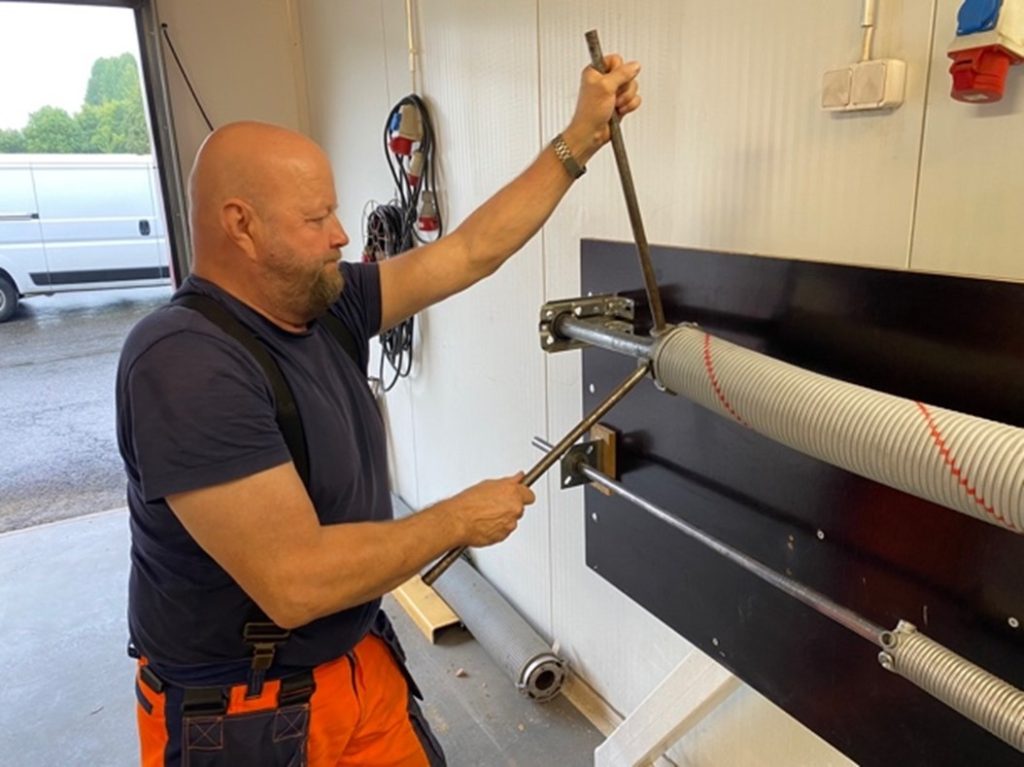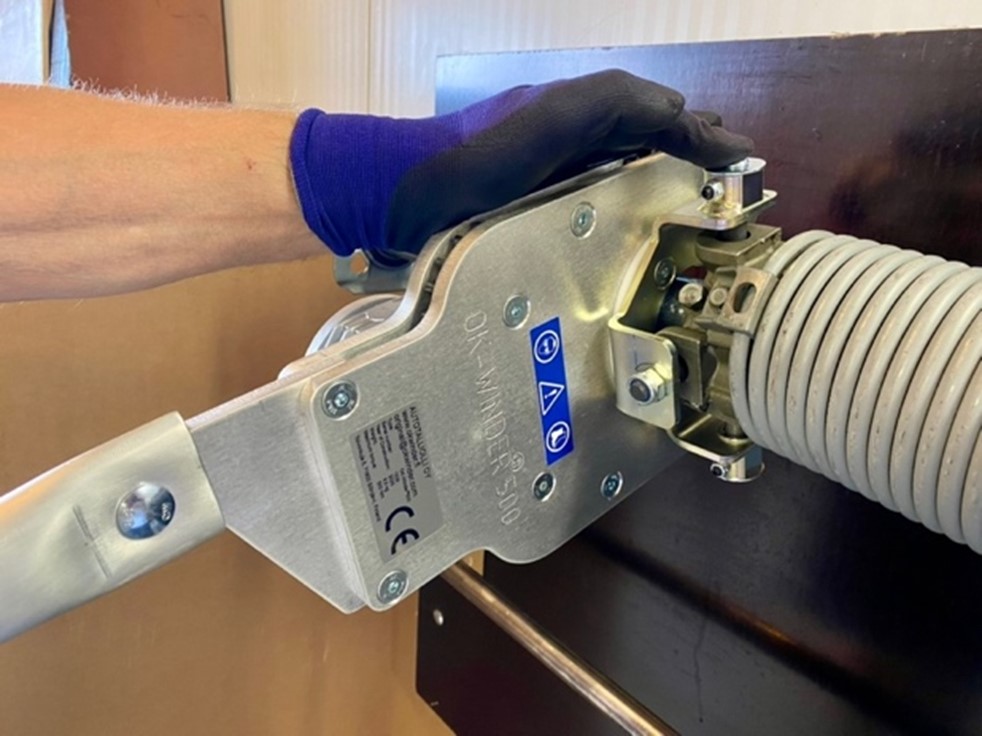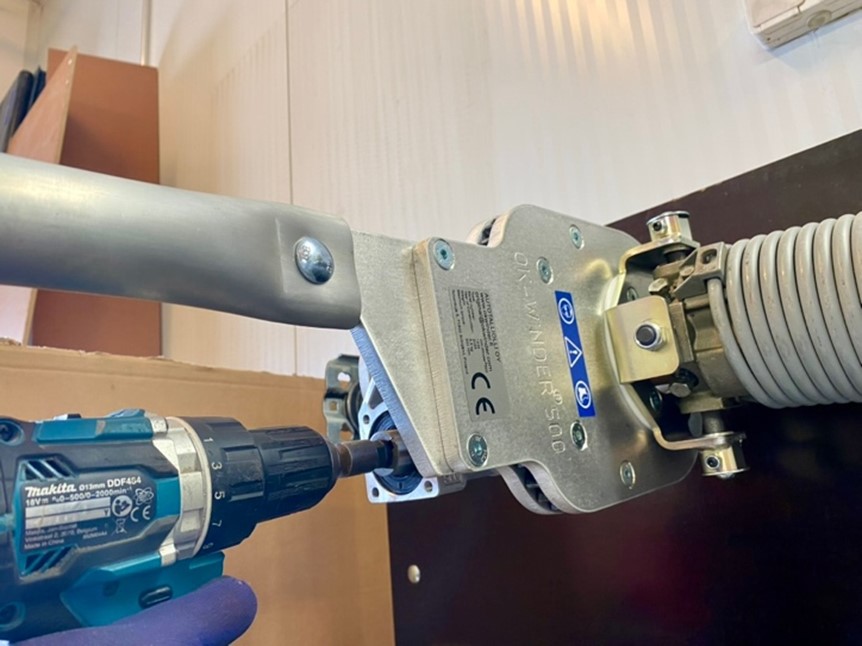Installation tools for industrial sectional doors. 🌎 WORLDWIDE DELIVERY!
Contact us: +358 400 679 300 / original@okwinder.fi
Installation tools for industrial sectional doors. 🌎 WORLDWIDE DELIVERY!
Contact us: +358 400 679 300 / original@okwinder.fi
OK-WINDER® 500 and OK-WINDER® 200 – WHY THEY BRING SAVINGS, SAFETY AND EFFICIENCY
Until recent years, tightening the springs on both industrial sectional doors and garage overhead doors has been based on the installer’s own muscle power. Two metal torsion bars are used to tension the springs. Since the torsion bars can only be controlled by the installer’s hand strength, the work is physically demanding, slow, and prone to accidents.
The door springs are highly tensioned. If the installer’s one hand slips off the torsion bar before the next bar is inserted into the hole, the spring tension will be released in a second. This means that the entire tensioning process must be started from the beginning. This also involves a high risk of injury. A loosened spring torsion bar can damage the door being installed, surrounding structures, and/or the installer themselves.
Springs that require frequent tightening are often located in hard-to-reach places, such as near the ceiling or behind the lift rails. Ventilation ducts may also prevent the normal use of bars. Working with spring torsion bars is therefore usually carried out either from a personnel lift. This forces often the installer to work with their arms raised. The working position is unergonomic, which puts particular strain on the shoulders and back.

Usually, springs can only be tightened a quarter turn at a time. Each turn requires considerable, increasing force. Applying force to the spring torsion bars means that the installer must lean or push the bars at an uncomfortable angle. If there is no space to tighten the spring, or if there are obstacles around it (see previously mentioned obstacles), it may be necessary to use shorter bars than usual, which require even more physical strength to use. This makes the work even more difficult.
Repetitive movements in difficult positions lead to fatigue and increase the risk of errors and accidents. This is particularly evident on construction sites, where there are several doors to install and the springs have to be tightened repeatedly.
OK-WINDER® spring tensioning tools have been developed by professionals for professionals, based on over 25 years of experience in door installation.
There are two spring tensioners in our product family:

OK-WINDER® tensioning tools are easy and safe to use. Both devices operate on the same principle. The OK-WINDER® spring tensioning tool is installed in the holes at the end of the spring and locked in place. This prevents the device from coming loose during spring tensioning.
The spring tensioner’s handle is placed against the railing of a personnel lift, for example, so that the installer does not have to support the device with their own muscle power as the spring tension increases.
Unlike traditional spring torsion bars, OK-WINDER® devices do not need to be moved when tensioning springs. The use of spring tensioning tools does not require a wide range of movement around them either. This makes the devices easy to use in hard-to-reach places, such as behind air conditioning ducts, electrical conduits, and overhead crane rails.
Spring tensioning, which was previously executed with spring torsion bars and muscle power, is now done with the OK-WINDER® spring tensioning tool, which is used with a cordless drill. (Note: Non-impact cordless drill!). The OK-WINDER® spring tensioning device does the hardest part of the installation work for the installer. Thanks to the device, the tensioning work is smooth, controlled, and physically light. If there is existing tension in the springs of industrial sectional or garage overhead doors, e.g. when dismantling old doors, OK-WINDER® tensioning tools can also be used to reduce the tension in the springs. The tools can be used to increase or decrease tension safely and effectively.
The use of OK-WINDER® devices significantly reduces the physical strain and fatigue associated with installation work, which greatly reduces the risk of accidents. In Finland, one day of sick leave due to a work-related accident costs the employer EUR 370 per day (according to calculations by the Confederation of Finnish Industries).
Roughly calculated, the OK-WINDER® 500 device pays for itself in about three sick days. The OK-WINDER® 200 spring tensioning device pays for itself in just over two sick days.
Using OK-WINDER® spring tensioning tools also saves time compared to traditional spring torsion bars. This is particularly evident in sites with multiple doors. With traditional spring torsion bars, tensioning springs is physically demanding and slow, requiring breaks after each spring is tensioned. OK-WINDER® devices do not require physical strength, which significantly speeds up the installation work while improving work safety.

OK-WINDER® products are manufactured in Finland and are made from 100% recyclable materials. High-quality and durable products are a matter of pride for us, which is why all our spring tensioning devices come with a two-year warranty.
Our company is committed to continuously developing our products and helping our customers with demanding and heavy door installation work.
OK-WINDER® products are the installer’s best investment.
Discover OK-WINDER® spring tensioning tools in our online store.